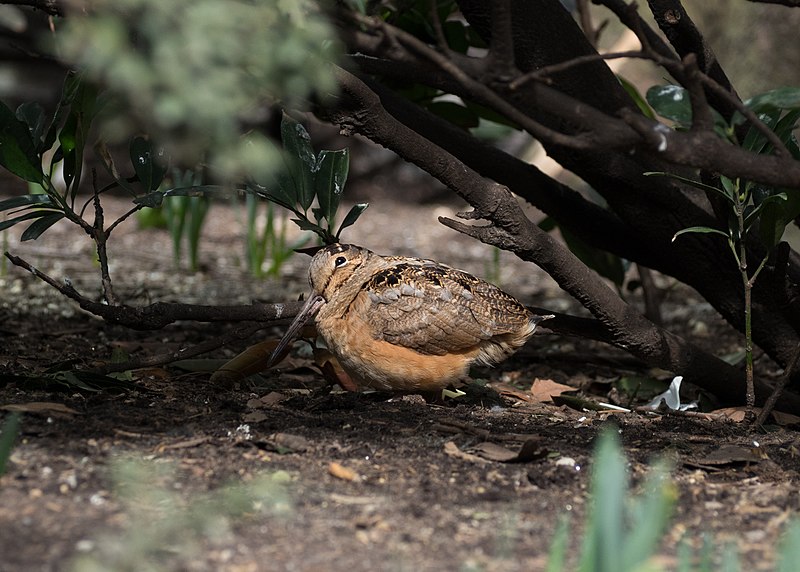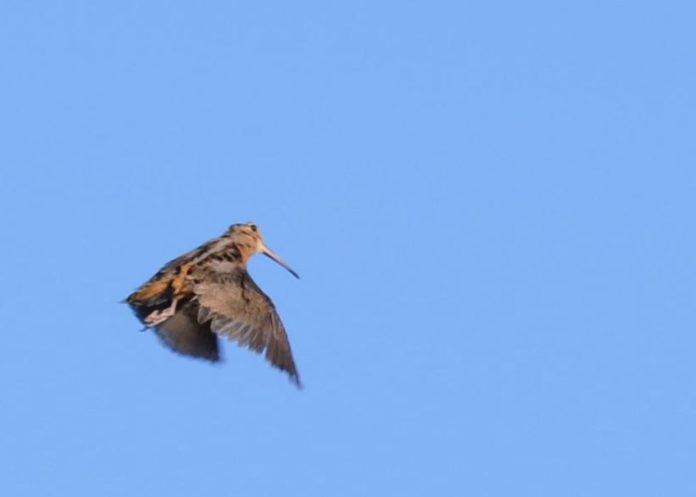NORTHERN RI –When strolling along country paths through woods and fields in Burrillville or North Smithfield, look closely on a cloudy day, or at dawn, or dusk on a moonlit night, and the rather elusive ground-dwelling timberdoodle bird, otherwise known as the American Woodcock, might make an appearance.
The birds, “don’t like old growth forests,” noted Carol Ayala, treasurer of the North Smithfield Land Trust. Rather, “early succession forest,” is what they like.
American Woodcocks like young forest and, “live in habitats where it’s fields transitioning into forest,” said Ayala, noting you may spot them, “if you clear cut an area where it is brushy and low.”
John James Audobon in, “The Birds of America,” from 1861 wrote that the American Woodcock is a gentle bird.
“Although a prober of the mire frequently alights in the interior of extensive forests, where little moisture can be seen, for the purpose of turning up dead leaves with its bill, in search of food beneath them, in the manner of the Passenger Pigeon,” wrote Audobon of the bird.
The sweet-looking, plump, child’s football-size American Woodcock – Scolopax minor – has a narrow bill of about 2-1/4 inches to a little over 3 inches in length, and the bird is well-feathered and well-camouflaged in woodsy shades of tan, brown, and black.
With eyes at the side of their heads, the birds have superb 360 degree eyesight range that enables them to spot predators. Woodcocks look, “like a character from a Dr. Seuss book,” notes an imaginative description on The Wild Bird Fund’s website.

Although it is rare to find the woodcock kept as a pet in these ecologically-enlightened times, the bird, “can be very easily domesticated …can be easily induced to feed on bread and milk reduced to the consistency of pulp, off which they ultimately become extremely fond,” wrote Frank Forester in an article, “Woodcock and Woodcock Shooting,” published in Graham’s American Monthly Magazine in 1850.
The birds’ long, slender bills are just right for pulling up from the ground their principal food: earthworms. But when the ground gets too difficult to drill, woodcocks will migrate to a warmer clime; for, the woodcock, “is a bird essentially of moderate climates, abhorring and shunning all extremes of temperature, whether of heat or of cold,” wrote Forester.
New York City is on their route, and a dangerous stopover for searching for food during the flight. The Wild Bird Fund comes to the aid of woodcocks that crash into buildings. The group rehabilitates the feathered beings and releases them back into the city, which is on the East Coast migratory flyway route.
Dozens get hurt. One woodcock suffered, “head and eye injury from his collision with the Starbucks window, so he was put on cage rest, given vitamin K to stop the bleeding and triple antibiotic ointment for his eye.”
Rehabbers say the birds have distinct personalities. For example, “Most birds would take that opportunity to put as much distance between us as possible, but instead our little Woodcock just stepped forward casually, slowly bobbed his head and began hunting for food as if we were simply a colorful group of tall trees.”
Among their own feathered tribe, the woodcock has no known dominance hierarchy. Generally, woodcocks are solitary beings.
They fly alone. But they fly in small flocks, and at night, when migrating.
The birds have a brief eight year or so lifespan.
Life is no walk in the park for the woodcock. Instead, the fluffy-looking flying animals face constant threat from predators. Carnivorous and omnivorous mammals stalk them, and snakes and other predators hunt the woodcock’s eggs.
The supposedly shy winged being is leery of human beings. What’s more the woodcock is, “quite popular as wild game, and hunters frequently target them in different parts of the world,” noted a write-up on Animals.net.
Woodcock hunters, “harvested 35,300 birds,” in the 2019–2020 hunting season in the Eastern Management Region, and a rough estimate is several hundred thousand were killed nationwide, according to the U.S. Fish & Wildlife Service.
In laboratories, vivisectors have used woodcocks as subjects, dousing the birds with pesticides to research the effects, according to The Journal of Wildlife Management.
On a side note, artists use in some paintbrushes feathers of the Eurasian Woodcock.
Although used as a laboratory model, and out in the woods a popular prey, the pejorative, “bird brain,” in no way applies to woodcocks, Eurasian or American. One sign of the birds’ cleverness is that they drum the surface of the ground with their wings to simulate rainfall, which draws their main food source – earthworms – to the surface, according to creation ecologist Tom Hennigan on icr.org.
Woodcocks, “use foot-stomping and shifts in weight to locate subsurface prey. If one of those movements causes an earthworm to move underground, a woodcock locates the worm either by hearing it or by feeling its vibrations through the bill, which it keeps in contact with the ground,” noted Keppie and Whiting in the 1994 US Forest Service.
The woodcock, “uses complex overlapping depth-perception vision, exquisite hearing, a tweezer-like bill with highly sensitive nerve endings, and sensitive feet that are designed to feet ground vibration and help to pinpoint a worm’s location,” writes Hennigan.
The smart birds also dine on insect larvae, snails, millipedes, grasshopper, crickets, spiders, ants and even grass and/or weed seeds.
The solitary living birds’ effective camouflage colors and pattern keeps them mostly hidden from predatory eyes; yet, when the time in nature is right, the male woodcock’s mating display, “is a sight to see and hear. Males establish and/or compete with other males for territories. This generally takes place in wet areas; old fields, balds and/or wetlands adjacent wooded areas,” noted Smoky Mountain Living.
“Song flight,” or, “sky dance,” are poetic descriptions of the male woodcock’s, “spectacular display.” The birds, “fly silently into the air, rising in continually widening circles up to about 100 meters. Their wings ‘twitter’ with increasing melody as they rise. They hover momentarily and begin singing and chirping vigorously, continuing to sing while fluttering down like a falling leaf. In the breeding season, the song flight follows a bout of peenting,” said Keppie and Whiting on animaldiversity.org.
“It’s just fascinating,” said Ayalo of the dance of the woodcock.
Woodcocks communicate through body movements and by vocalization, calls: peent, chirp, cackle, and tuko.
Ayalo has heard the birds call in the border area of Smithfield and North Smithfield, as well as in the general vicinity of Tarklin Road, and Colwell Road, areas of Burrillville.
In flight the woodcock’s movement is, “like a fluttering, unpredictable dance or zig-zag to the top of the canopy,” notes A Guide to American Woodcock Hunting. Once past that, they tend to take off like rocket ships or, as the folks from Modern Wild would say, like “timber rockets.”
“Sometimes they will liftoff in a deliberate and direct pattern, which some would argue is a tell-tale sign of a resident bird knowing how to escape,” notes the guide. “Weak flyers are often considered tired flight birds, but neither assumption has been scientifically proven.”
Strolling along country paths through woods and fields in northwestern Rhode Island, listen for the woodcock and one might just step into sight. In case one doesn’t show up, a website full of woodcock calls, photos, and videos to enjoy can be found at https://birdsoftheworld.org/bow/species/amewoo/cur/introduction.








